15/02/2021
Mileage fraud can illegally inflate the value of a used car by 25%

Tadas Švenčionis

Drivers of different countries tend to swap their cars every 3 to 5 years. That means they may sell old and buy younger cars 2 to 3 times during one decade. The problem of odometer rollbacks doesn’t go away, and people lose a lot of money because of this alone.
Mileage frauds are one of the biggest problems of the used car market all over the world. It is complicated to identify the criminal responsible for the odometer rollback from the law legislation point of view. However, with this disturbing trend still being present, unfair people continue boosting their vehicles’ value by doing the obvious - faking the mileage.
The largest car history check platform carVertical did a research study to find out what cars have odometer frauds most usually. More than 570,000 car history reports were analyzed to get precise results. The research reveals how much money do the drivers overspend when buying a car with mileage rollbacks.

Afraid of buying a wreck?
Check any VIN to learn a vehicle's full history!
The domination of diesel-powered cars
Out of all car history reports made in 2020, the majority of mileage frauds were spotted on diesel-powered cars. It consists of nearly three-quarters (74.4%) of all car history reports with spotted mileage corrections. Diesel engines are usually the choice for drivers who cover greater distances each day. That is the main reason why such cars have fake odometer readings on the second-hand market.
Used petrol-powered cars are less likely to have mileage frauds, with 25% of all spotted odometer rollbacks. However, the trend may change in the future because diesel and petrol proportions in brand-new car sales have changed dramatically over the past years.
Electric cars and hybrids with fake odometer readings are amongst the rarest observations, with only 0.6% of spotted mileage fraud cases.

Cheap crime, significant gains (or losses)
One of the main reasons why mileage frauds are so famous amongst unfair car sellers is the cost performance. The odometer may be clocked with as little as a couple of hundred euros, even for well-secured cars with up-to-date software. But the damage to society is way bigger than that.
As carVertical research revealed, depending on the age and state of a used car, mileage rollback could artificially inflate the car’s price up by as much as 25%. Data shows that the cost of vehicles imported from the USA usually can increase by up to eye-watering €6000. And that is achievable only via clocking the odometer readings.
Without the awareness of car history, the buyer may overpay as much as a couple of thousands of euros.
Older cars tend to have bigger rollbacks
According to the research, the most commonly clocked cars are the ones made between 1991 and 1995. Vehicles of this age group have mileage frauds of an average value of 50,000 miles (80,000 km).
No surprises here, since older cars are cheaper and more straightforward from the technical point of view. It is easier to change the odometer readings in that case.
Vehicles made from 2016 to 2020 had their odometer readings changed by an average value of 22,000 miles (36,000 km). However, the damage of such fraud may be several times greater than for the cars of a much older age group.
The research study found out that sometimes mileage frauds can reach up to 125,000 miles (200,000 km) or even 250,000 miles (400,000 km).

Concluson
Many used car buyers are not aware of the history of the vehicle they’re interested in. Moreover, some sellers don’t know what the car has been through. A car history report may unveil some facts that will help avoid becoming an owner of a bad-maintained car. It can provide an advantage for negotiations, too.
25% of the value of a car may seem like a reason to check the history online.

Check your registration number
Avoid costly problems by checking a vehicle's history. Get a report instantly!

Article by
Tadas Švenčionis
Tadas is the Editor in Chief of the carVertical Blog. A fan of all things automotive and tech, he makes a point of making complex topics simple and engaging – after all, what good is a story no one understands? Tadas spends his free days reading, gaming, and bringing music no one’s asked for to Vilnius, Lithuania.
